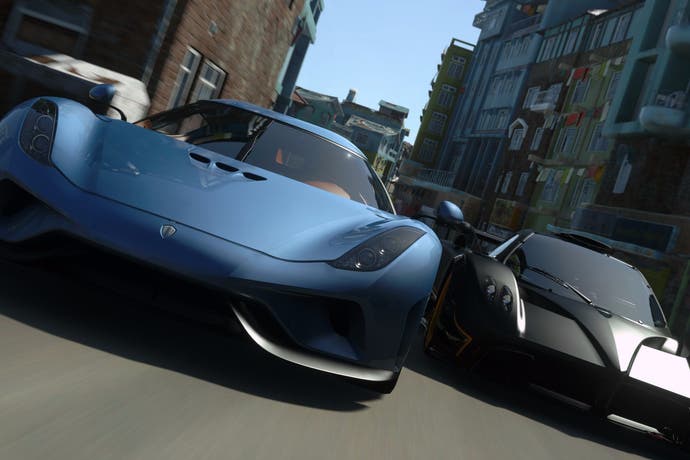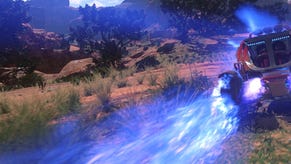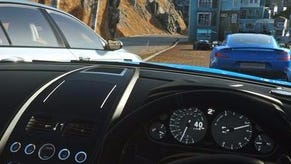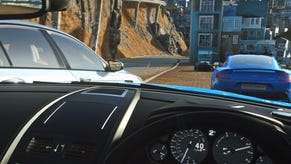DriveClub VR review
Vroom for improvement.
Cars can do strange things to men, and none stranger than what happened to Matt Southern as he revealed Evolution Studios' DriveClub on-stage at the dawn of the PlayStation 4. "We've modelled the direction of each metallic flake of paint in multiple layers," he drooled, explaining the exquisite detail on each of DriveClub's cars. "We've emulated each thread of the weave of the carbon fibre!" By this point Southern's eyes had darkened into slick pools of car oil; you could sense him muttering the hum of a straight 6 to himself under his breath. "Even the suede and carpet have a fibre direction map!"
All that detail might have been obscured by an infamously stuttering start, and of course Evolution Studios has since been shuttered and its staff subsumed by Codemasters, yet despite its early failings DriveClub came to be cherished by many; an arcade racer with a remarkably pure heart and astounding visuals, it blossomed into one of the PlayStation 4's finest exclusives. DriveClub VR finds itself in an odd position, poised to take a posthumous victory lap for one of the generation's stranger success stories. It doesn't quite pan out that way.
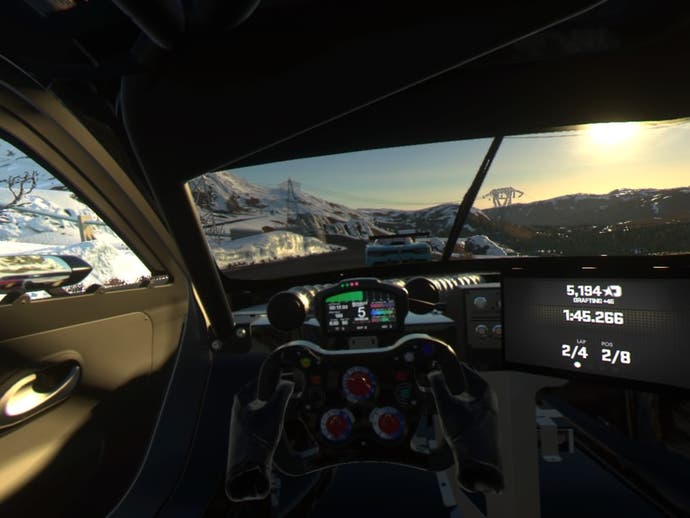
Still, all that detail that was pored over at DriveClub's reveal has never been better served. DriveClub VR's cockpits are the real stars here, lovingly recreated cabins that help immerse you totally in your environment. It's an incredible interactive automotive showroom where you can smell acres of premium plastic and fresh leather, where you can lean in and read the digital dials or simply appreciate the lurid finish of a Pagani's dashboard. There's a premium feel to this part of DriveClub VR that matches the subject matter - the artistry on display here is exquisite.
Beyond the cockpit DriveClub VR doesn't quite fall apart, but it certainly disappoints a little. The sense of speed - always one of DriveClub's trump cards - is intact, and is a perfect fit for VR. Racing games come alive when played with a headset, and DriveClub is no exception, the ability to look to apexes and pick out exit points enhanced no end and making the driving that much more satisfying. The driving itself is great, too, as you'd know if you'd already sampled Evolution Studio's weighty yet accessible handling model that does a great job in providing you with pliable momentum. Swinging supercars around corners has rarely felt so satisfying.
The visuals that also helped earn DriveClub its following have taken a hit here - understandably so, but to a noticeable degree. Beyond the windscreen, and beyond those lush interiors, the visual splendour that DriveClub has dined out on these past few years is washed out to an unfortunate smudge. Those long, lovely vistas of Scottish highlands warmed by low evening suns are smeared to the point where it's like playing DriveClub while submerged in water.
Which is fitting how so much of this feels like a watered down DriveClub. Strip down DriveClub's exceptional visuals and you're left with a competent, enjoyable but quietly unremarkable racer that's saved by its resolutely old school personality. There are no rewinds here, no dynamic open world - it's just you, your competitors and a ribbon of road. Vanilla DriveClub built upon that in new, often surprising ways, relishing in its splendour with a photo mode, adding spectacular weather effects and in its final days even introducing motorbikes into the fray. None of those find their way over to DriveClub VR, so if you're coming from the original it can feel like something of a backwards step.

Some surprises for DriveClub veterans do find their way into this. Five new tracks build upon the urban focus introduced in one of the original's final updates, bringing tours of cities and towns in the game's existing locales. They're kind of awesome, especially the ludicrous inclines that wind their way up and down through a colourful village in India - but they're all also coming to the vanilla game as a free update. In light of that, it seems strange that this diluted DriveClub is being offered as a relatively expensive standalone.
To pin too much on that peculiar decision would be doing a disservice to the great work that's been done here to make a compelling VR game. A fair amount of thought has been put into what makes VR a success, from the little things such as the ability to reset your driving position at the start of each event to bigger upheavals such as the way the UI now sits neatly on a monitor positioned on each car's dashboard. There's a magic to driving games in VR, and DriveClub isn't immune to it. At the launch of PlayStation VR, it's as good a showcase as any for what virtual reality can do.
If you're a returning DriveClub player, however, you might feel a little short-changed. The fundamentals are as entertaining as ever, and this digest of one of the generation's best driving games is still one of PlayStation VR's most complete games at launch. A small shame, then, that in the process of being ported to VR DriveClub has lost more than it's gained.
